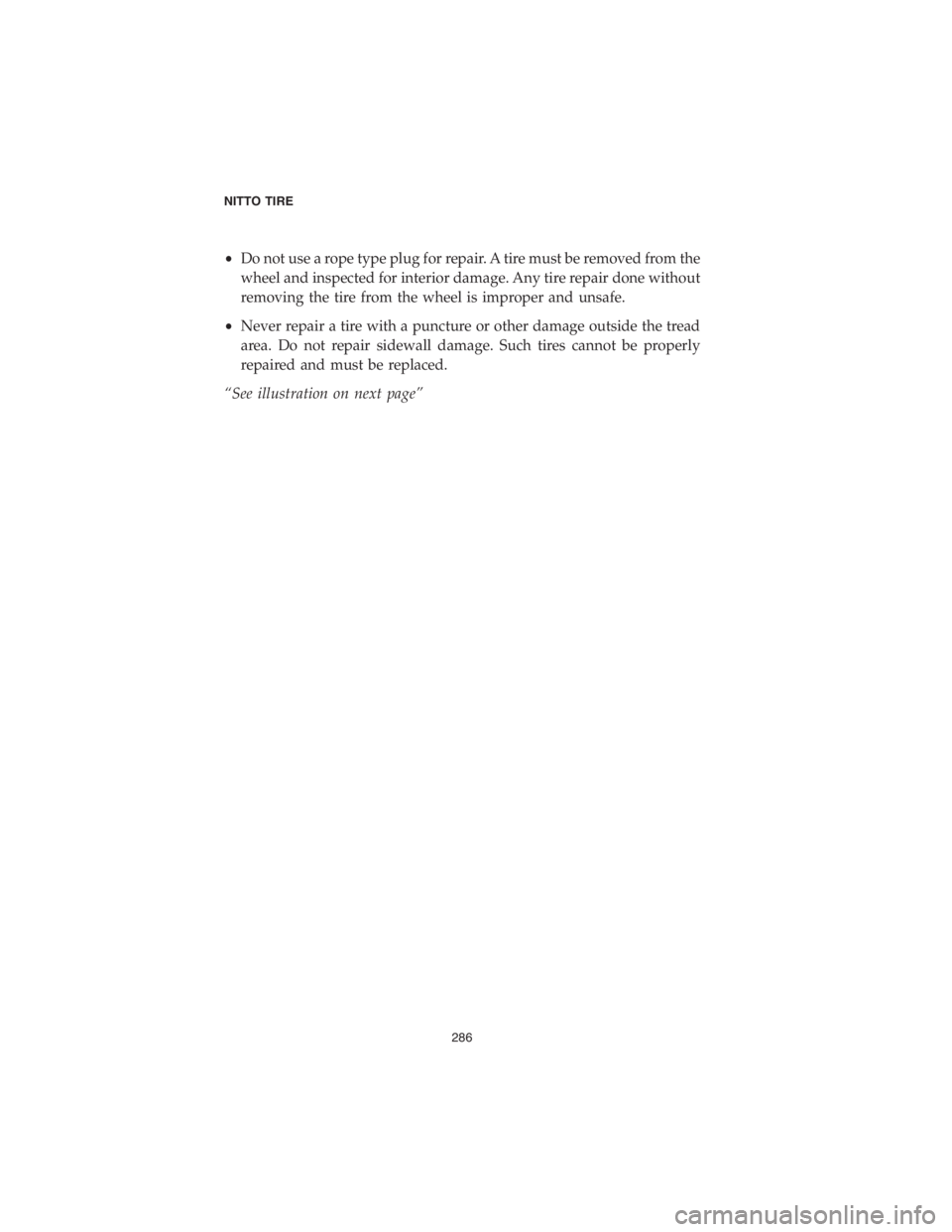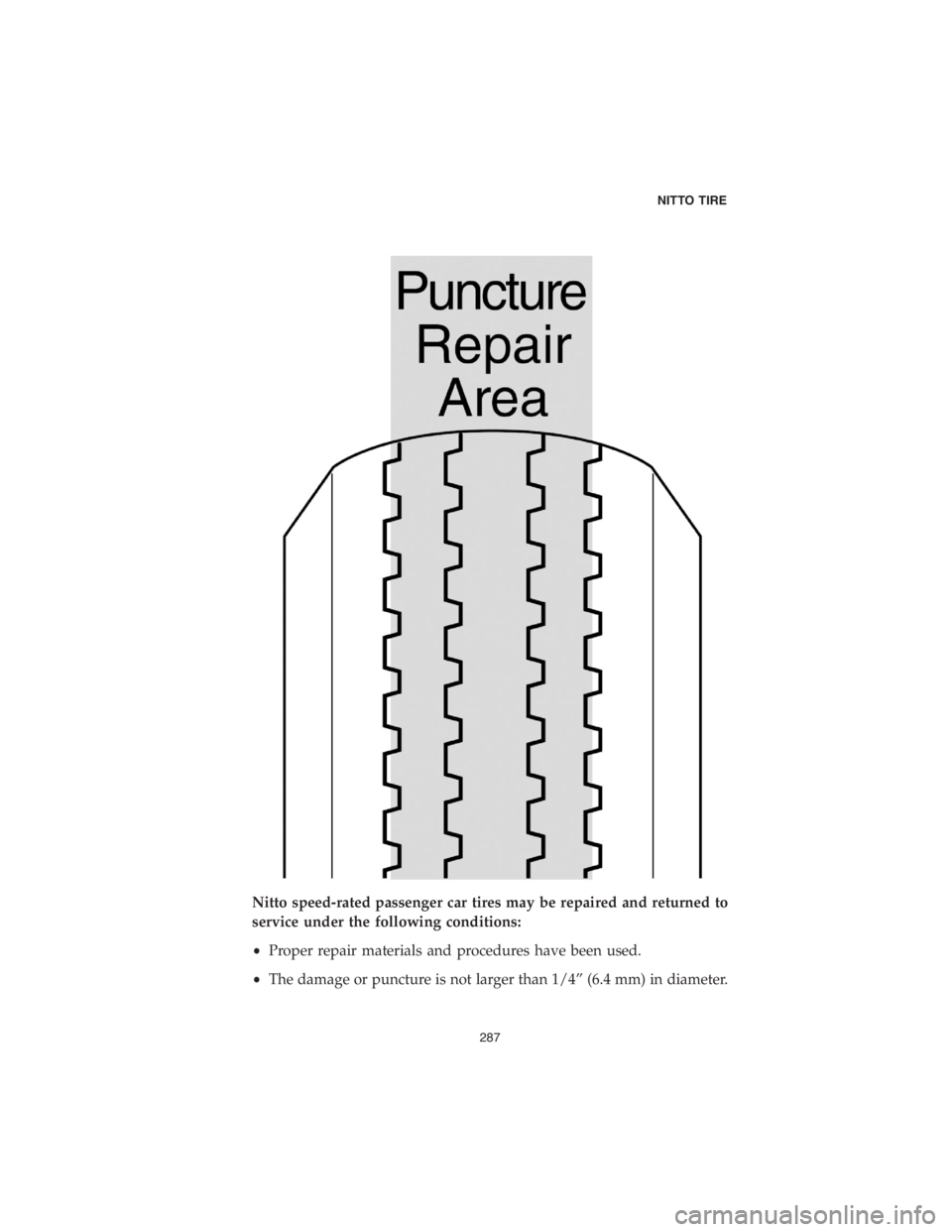2018 DODGE DURANGO SRT tires
[x] Cancel search: tiresPage 285 of 316

•Inspect your tires for adequate tread depth. When the tire is worn to
the built-in indicators at 2/32” (1.6 mm) or less tread groove depth, the
tire is worn out and must be replaced. Never drive on tires to the point
that the tire cord or the fabric is exposed.
•Inspect your tires for uneven wear. Wear on one side of the tread or flat
spots in the tread may indicate alignment or other problems with the
tires or the vehicle. Consult your authorized Nitto dealer.
WARNING!
Never drive on a tire if there is any evidence of damage. Driving on
a damaged tire is dangerous. A damaged tire could suddenly fail,
which may result in loss of vehicle control and lead to serious
personal injury or death. Do not attempt to dismount, mount, or
repair a tire yourself. See your Nitto dealer immediately if you
detect damage.
IDENTIFYING DAMAGED WHEELS
Periodically check to see if any of the following symptoms exist, in which
case the wheel must be replaced:
•If the flange is bent.
•If welds or rivets are leaking.
•If the stud holes are elongated and not round. (Improper lug nut
tightening could cause this.)
•If there are cracks in the wheel.
WORN OUT TIRES
Tires must be replaced when tread is worn to 2/32” (1.6 mm). Treadwear
indicators on Nitto tire treads show the 2/32” depth (1.6 mm). Most
states require that tires be replaced when the tread depth is worn to 2/32”
(1.6 mm). Tires may lose sufficient wet and snow traction before reaching
2/32” (1.6 mm) of wear. Many wet weather accidents result from
skidding on worn out tires.
Excessively worn tires are more susceptible to penetrations. Consider
replacing your tires earlier if you drive in snow or wet conditions.
NITTO TIRE
284
Page 286 of 316

WARNING!
Continued operation of your vehicle with excessively worn tires
may lead to loss of vehicle control in adverse weather conditions,
tire failure, and serious personal injury or death.
Any retail tire dealer will be glad to measure your tire’s tread depth for
you. Nitto recommends that tires be replaced in matched sets of four.
TIRE REPAIRS
If any tire has sustained a puncture, have the tire dismounted and
inspected internally by an authorized Nitto dealer for possible damage
that may have occurred. Only specially trained personnel using the
proper tools and procedures should repair tires.
WARNING!
Before having your tire repaired, tell your authorized Nitto dealer if
you have used an aerosol puncture sealant to inflate/seal the tire.
Aerosol puncture sealants could contain a highly flammable,
explosive gas.
Driving on an improperly repaired tire is dangerous. An improper
repair can cause further damage to the tire. It could fail suddenly,
which can result in loss of vehicle control and lead to serious
personal injury or death. To insure safety, go to your authorized
Nitto dealer for professional inspection and proper tire repairs.
Cosmetic Tire Alterations Can Be Dangerous! Remember — Do not
perform or allow anyone to perform any alterations to your tires.
Alterations may prevent proper performance, leading to tire
damage, which could result in sudden tire failure and loss of vehicle
control and lead to serious personal injury or death.
•Never repair a tire with 2/32” (1.6 mm) or less tread remaining. At this
tread depth, the tire is worn out and must be replaced.
•Never repair a tire with a puncture larger than ¼” (6.4 mm) in
diameter. Such tires cannot be properly repaired and must be replaced.
•Repairs of all tires (radial and non-radial) must be of the plug and
inside patch type. Using plugs alone on any type of tire is not a safe
repair.
NITTO TIRE
285
Page 287 of 316

•Do not use a rope type plug for repair. A tire must be removed from the
wheel and inspected for interior damage. Any tire repair done without
removing the tire from the wheel is improper and unsafe.
•Never repair a tire with a puncture or other damage outside the tread
area. Do not repair sidewall damage. Such tires cannot be properly
repaired and must be replaced.
“See illustration on next page”
NITTO TIRE
286
Page 288 of 316

Nitto speed-rated passenger car tires may be repaired and returned to
service under the following conditions:
•Proper repair materials and procedures have been used.
•The damage or puncture is not larger than 1/4” (6.4 mm) in diameter.
NITTO TIRE
287
Page 289 of 316

•The repair will be the first repair performed on that tire. (Only one
repair per tire is permitted in order to maintain a limited speed rating.)
•The tire must have more than 2/32” (1.6 mm) of tread remaining.
Nitto speed-rated passenger tires that have been properly repaired
qualify for reduced speed ratings as follows:
ORIGINAL SPEED RATING AFTER PUNCTURE REPAIR
(Y), Y, W, Z, V, VR, H H (maximum speed 130 mph)
TT
SS
The maximum speed of a vehicle is limited by the lowest-speed- rated
tire on the car.
mNOTICE!
A tire’s speed rating is void if the tire has been retreaded, damaged, abused, or
otherwise altered from its original condition. Thereafter, it should be treated
as a non-speed-rated tire. In addition, retreaded passenger and light truck
tires are not warranted by Nitto for any reason. Nitto speed ratings are
voided for retreaded tires.
PROPER SELECTION OF TIRES
When tires need to be replaced, don’t guess what tire is right for your
vehicle. First look at the vehicle Owner ’s Manual or the Tire Information
Placard. They tell you the size of the tires that were on the vehicle as
original equipment.
Replacement tires for any vehicle must be of a size, load range, and load
capacity (by inflation) that is capable of supporting the same load as the
vehicle’s originally installed (OE) tires. Avoid installing used tires on a
vehicle. There is no way to determine what road hazards or abuse a
previously owned tire may have incurred.
WARNING!
Failure to install tires with adequate load capacity will result in tire
fatigue and sudden tire failure. This could lead to loss of vehicle
control, possibly resulting in personal injury or death.
(Continued)
NITTO TIRE
288
Page 290 of 316

WARNING!(Continued)
Certain vehicle performance parameters, including ride comfort and
handling, may be affected by substitute tire sizes. In some cases,
particularly for SUVs and light trucks, a failure to follow the vehicle
manufacturer ’s recommendations for tire replacement could
adversely affect the safe handling of the vehicle, possibly resulting
in a loss of vehicle control leading to personal injury or death.
The following procedures concerning replacement tires must be fol-
lowed:
•Confirm that the load-carrying capacity is greater than or equal to the
load-carrying capacity of the OE tire size at the pressure indicated on
the vehicle Tire Information Placard.
•Carefully note any differences between recommendations for front and
rear axle positions regarding the tire size and/ or inflation pressure.
•The speed rating must be equal to or greater than what is specified by
the vehicle manufacturer if the speed capability of the vehicle is to be
maintained.
•Tires should be mounted on approved wheel widths. If changing tire
sizes, check to make sure the wheel has adequate load and inflation
pressure capacity.
•Body and chassis clearance must be checked on the vehicle’s front and
rear axles.
In addition to the above, light truck tire replacements should take into
consideration the following:
•Proper spacing between dual tires is necessary for optimum tire
performance. If chains are used, particular care must be taken to assure
adequate clearance between loaded tires to avoid damage from the
chains. The allowable outside diameter difference between a tire and
its dual mate is ¼” (6.4 mm) for light truck tires.
CONSIDERATIONS IN PLUS SIZING
Always refer to and follow the vehicle manufacturer ’s replacement tire
recommendations. In some cases, a vehicle manufacturer may specifically
advise against the application of replacement tires that are not of the
original size or type.
NITTO TIRE
289
Page 291 of 316

TIRE AND WHEEL MATCHING AND MOUNTING
WARNING!
Any attempt to mount a tire on a wheel with a different diameter
will result in an explosion of the tire/wheel assembly that could
cause severe personal injury or death.
Prior to mounting any tire, always check the wheel identification
stamp to verify the correct wheel diameter. Always check the tire
size molded onto the sidewall.
Never exceed 40 psi when seating the tire beads onto the wheel.
Always stand well clear of any tire mounting operation. This is
especially important when the service operator inflates the tire. If
the tire has been improperly mounted, it could burst with explosive
force causing serious personal injury or death.
A new valve stem must be installed on the wheel each time a
worn-out passenger or light truck tire is replaced.
Removing and replacing tires on wheels can be dangerous.
Attempting to mount tires with improper tools or procedures could
result in a tire explosion, causing serious personal injury or death.
This is a job for your authorized Nitto dealer or other qualified tire
service location only.
Serious personal injury or death can result from:
•Failure to select the proper tire and wheel. The tire must match the
width and diameter requirements of the wheel. When mounting
truck type radial tires use only wheels approved for radial tires.
•Failure to inspect both the tire and wheel. The wheel must be free
of cracks, dents, chips, and rust. The tire must be free of bead
damage, cuts, and punctures.
•Failure to follow proper procedures. For proper mounting proce-
dures, consult the Rubber Manufacturers Association’s publication
“Care and Service of Automobile and Light Truck Tires” (ref.:
www.rma.org).
•Exceeding the maximum bead seating pressure of 40 psi. Be
absolutely certain beads are fully seated before adjusting the
inflation pressure to the level recommended for vehicle operation.
Never put flammable substances in the tire/wheel assemblies at any
time. Never put any flammable substance into a tire/wheel assembly
and attempt to ignite it in order to seat the beads.
NITTO TIRE
290
Page 292 of 316

TIRE MIXING
WARNING!
Driving your vehicle with an improper mix of tire sizes,
constructions, and speed ratings can be dangerous. Your car ’s
handling characteristics can be adversely affected. You could have
an accident resulting in serious personal injury or death. Consult
your vehicle Owner ’s Manual or an authorized Nitto dealer for
proper tire replacement.
•Nitto recommends that all four tires be of the same size, speed rating,
and construction (radial or non-radial). In some cases the vehicle
manufacturer may require different sized tires for the front or rear
axles. Never mix P-metric or European Metric passenger tires with
LT-metric tires on the same vehicle.
•Match tire size designations in pairs on an axle, except during the
temporary use of a spare tire.
•If two radial tires and two non-radial tires are used on a vehicle, put
the radials on the rear axle. If radial and non-radial tires are used on a
vehicle equipped with dual rear tires, the radial tires may be used on
either axle.
SPEED-RATED TIRES
•If the vehicle Tire Information Placard and/or the vehicle Owner ’s
Manual specifies speed-rated tires, the replacement tires must have the
same or higher speed rating to maintain vehicle speed capability.
•If a replacement tire has a lower speed capability than that specified by
the vehicle manufacturer, the vehicle’s speed must be restricted to that
of the replacement tire. Vehicle handling could also be affected.
Consult the vehicle Owner ’s Manual or tire manufacturer for
recommendations.
•If tires with different speed ratings are used, it is recommended that
the lower-speed-rated tires always be placed on the front axle. This is
to prevent a potential oversteer condition.
NITTO TIRE
291